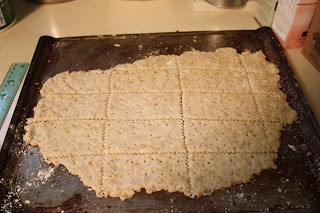I opened the book to the recipe for this week, Pita Breads, and found notes I had made from a previous time. I think I must have baked this at the time I first got the book - I remember being fascinated by the video, seeing the way they puffed in the oven (more on that later....)
 |
| Sponge after rising and mixing in salt and olive oil |

The dough rises for 2-3 hours, and then it's time to roll it out. The batch of dough makes 16 breads, each about 6" or more. You need to roll it fairly thin, but thanks to the long rising, kneading, and oil, this dough is fairly sturdy, and just needed a little flour to help keep it from sticking.

I baked the rounds on the pizza stone, at 450 degrees, for just 3-5 minutes. And I remember this from last time - some of them puffed wonderfully, and some did not. I would love to know the secret of this so I can get it right every time!
We ate this bread wrapped around greek-flavored lamb and vegetables, and it was still good the next day for breakfast and lunch. I stored it in a plastic bag to keep it soft. Very good! I would make this one again, although if anyone out there has got the secret to puffing pita bread, I want to hear it :-)








